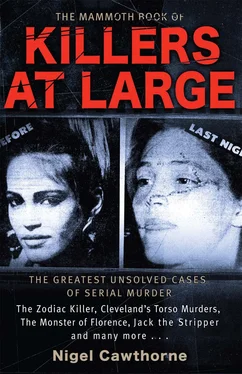At the post mortem conducted at the Orleans Parish Coroner’s office, it was discovered that she had been sexually assaulted. The cause of death was a knife wound to the neck. Again something was missing. The killer had taken a silver toe ring from Kinamore’s body. The police quickly tied her killing to those of Gina Green and Charlotte Pace—and another case.
Two days after Pam Kinamore had gone missing, a 28-year-old Mississippi woman was raped by a man who had forced her into a white pick-up on Interstate 10 that runs westwards from Baton Rouge to Layafette. After the assault, he had let her go and she gave the police a good enough description of her attacker for them to put together a composite.
Then, a week after Kinamore’s body had been found, a woman came forward claiming that she had seen a woman answering Kinamore’s description slumped in the passenger seat of a white pick-up truck the night she had gone missing. She appeared to be sleeping or, perhaps, dead. The truck had been speeding westwards down I–10 at around three o’clock in the morning. It had turned off at the Whisky Bay exit, the ramp nearest to where Pam Kinamore’s body was found. The driver was a white male who, the witness said, had a slight build. This was surely the same man as the mystery rapist.
The police now put together a detailed description of the vehicle. They said they were looking for a white General Motors—or possibly a Chevrolet—pick-up truck, thought to be a 1996–97 single cab model. The licence plate was thought to contain JT341, though it was not known which state had issued it. The witness also said she had seen the shape of a fish on the rear offside of the pickup.
In August 2002, a multi-agency murder task force was formed, comprising 40 officers from Baton Rouge Police Department, West Baton Rouge Parish Sheriff’s Office, Lafayette Parish Sheriff’s Office, Iberville Parish Sheriff’s Office, the Louisiana State Police and the FBI. They believed that drawing on the resources of all their agencies would help catch the killer more quickly.
DNA evidence linked the murders of Gina Green and Charlotte Pace. Later the Louisiana State Crime Lab managed to show that Kinamore had been killed by the same man. Now certain that they had a serial killer on the loose, the police began combing through unsolved homicides over the last ten years.
In mid-August another witness came forward. A woman told WDSU News Channel 6 that, when she was packing her groceries in the Winn Dixie food store, a strange man approached her. He said that he worked in construction and that his name was Joe. He then followed her out into the parking lot, carrying a jug of water. Ungallantly, he drew attention to her large size and said that he could lift her up. Even so he asked her to go out with him that night and appeared disappointed when she refused. But he was persistent and said he wanted to give her a gift. He went over to a large white truck that matched the description the police were now circulating. From the back of the truck, he took a tree vine which he gave to her. After he drove off, she called the police.
On 21 November 2002, 23-year-old Trineisha Dene Colomb disappeared. At around half-past-one in the afternoon her black 1994 Mazda MX3 was found on Robbie Road in the small town of Grand Coteau, 50 miles west of Baton Rouge and some 12 miles north of Layafette. The keys were still in the ignition, but Colomb was nowhere to be seen. Her naked body was found by a rabbit-hunter in a wood 30 miles away, three days later. Colomb was a US Marine and fought back before she had been bludgeoned to death. DNA evidence soon linked Colomb’s killer with the Green, Pace and Kinamore murders.
There were other similarities with the earlier murders. Another footprint was found, again of a man’s athletic shoe in size 10 or 11. CNN identified it as the latest model of a $40 Adidas-style basketball shoe on sale widely in the area. And some of the victim’s possessions were missing, including a ring with the word “Love” inscribed on it. But there were some unique features. This was the first time the killer had struck outside Baton Rouge itself and Colomb was thought to be the Baton Rouge serial killer’s first known black victim.
On the day Colomb went missing, a white pick-up truck was seen in the same wooded area where her body was found. The driver was described as around 35 years old and white, and investigators released a new composite showing “a person of interest”.
The task force actively solicited help from the public. In November 2002, DNA samples were collected from 600 volunteers. Mouth swabs were taken from another 100 potential suspects the following month.
The police took the unusual step of issuing a detailed profile of the man they sought. He was, they thought, aged between 25 and 35. He earned less than the average income and his work did not bring him into contact with other people. It was probably an occupation that required physical strength, such as construction. He had shown himself strong enough to fend off a US Marine and carry the dead body of Pam Kinamore over a boggy terrain.
The killer was insecure around women, particularly women who displayed any sort of sophistication. Most women would have thought him awkward, but dismissed him as harmless. However, in some he might have developed an obsessive interest—to the point where they would have cause to become afraid. There was evidence he had stalked his victims before attacking them. And though the killer was sometimes impulsive, the murders seem to have been planned.
The profilers hoped that the killer would give himself away. They believed that he would be preoccupied with news of the killers and was likely to display anxiety, irritation and even intense anger at the coverage. He might even openly criticize any progress made in the investigation and blame the murdered women for their own deaths.
With the growing publicity surrounding the Baton Rouge serial killer, enrolment in self-defence classes soared, along with sales of guns and pepper spray. Attendance at Louisiana State also climbed with students turning up to class rather than staying at home where they feared being abducted and murdered.
The task force investigators began using roadside electronic billboards to keep the public up to date with the investigation. First two, then six in 2003, covering the Baton Rouge and Lafayette areas. However, after 18 months they seemed no closer to catching the killer. The task force then drew flak from Dr Robert Keppel, the noted criminologist who had been involved in the investigation of the Green River killer and Ted Bundy. He identified four major mistakes made by the task force.
He criticized their use of the media. Releasing details of the killer’s shoe prints might induce him to destroy the identifying footwear, making it more difficult to prove the case against him if and when he was caught. And revealing the DNA links between the victims might also hinder the investigation, Keppel said, as the killer would take more care about leaving behind genetic evidence in future crimes. Keppel was no fan of psychological profiling, which he believed only overloaded the investigation with extraneous information. Detectives should not be looking for the type of unusual character suggested by the profile, but rather the type of man who blends in and is easily overlooked. The task force should comb its files as they probably contained the killer’s name already. Keppel maintained that investigators usually came across the name of the killer in the first 30 days of an investigation, which was overlooked as a deluge of fresh information flooded in.
In March 2003, the Baton Rouge serial killer struck again. The next victim was Carrie Lynn Yoder, a 26-year-old post-graduate student at Louisiana State. She lived alone at 4250 Dodson Avenue not far from Charlotte Pace and Gina Green. On 3 March, she told Lee Stanton, her boyfriend of three years standing, that she was going to the Winn Dixie grocery store on Burbank Drive. They arranged to talk again later that night or the following day. When she did not call he began to worry. On 4 March, he drove by her house and noted that the lights were on and her car was outside, but he left it at that. The next day, as he still had not heard from her, he went back to the house. The back door was open and he went in. Her keys, purse and cell phone were on the counter. Everything else seemed to be in order, except for a wall-mounted key rack near the front door. It was hanging by one screw as if it had been dislodged in an altercation. Stanton called the police.
Читать дальше











